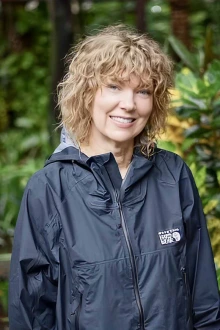When her dreams speak, Kenna Stephenson listens
Dreams propelled the physician and professor to search for her birth mother and to study the dreams of postmenopausal women.

Kenna Stephenson, MD, is an associate clinical professor of family, community and preventive medicine at the University of Arizona College of Medicine – Phoenix.
Photo by Noelle Haro-Gomez, U of A Health Sciences Office of Communications

Kenna Stephenson, MD, in a remote region in Rio Dulce, Guatemala, in 2022 on a Team-5 Medical Foundation mission.
Photo by Chris Duncan
In a dream, Kenna Stephenson, MD, is holding onto a golden rope and guiding herself forward and upward along a spiraling path. With each step she takes, she feels lighter and warmer. She begins propelling herself forward more rapidly. She is surrounded by a sense of serenity and peace. Suddenly she stops and looks down at the rope in her hands and realizes it is an umbilical cord and it is attached to her. When she wakes, she feels an intense need to find her birth mother.
“When our dreams speak, we are wise to listen,” said Stephenson, an associate clinical professor of family, community and preventive medicine at the University of Arizona College of Medicine – Phoenix.
Stephenson, who was adopted shortly after her birth, said the call to find her birth mother became stronger when she became a mother.
“As I crossed the threshold of motherhood and began anew the childhood journey through my daughter, my thoughts and then my dreams urged me on this quest,” she said.
While the dreams were often different, the theme was always the same: She needed to find the woman who gave birth to her.
But even before those motivating dreams, Stephenson said it was her dream world that guided her at 5 years old toward becoming a doctor.
“I feel that being a doctor was in my subconscious and my superconscious, because it came so natural to me. I think that as soon as I saw doctors, hospitals and clinics, I instantly would feel at home in those places. So, when I understood the word doctor and what it was, I was like, ‘Oh yes, that's what I am going to be,’” Stephenson said.
Dream research
Stephenson obtained a bachelor’s degree at the University of Texas at Austin, earned her medical degree at Texas Tech University in 1989 and completed a family medicine residency at the University of Texas Health Science Center at Tyler in 1992. She joined the College of Medicine – Phoenix in 2022.
While teaching in the Doctoring Program and Capstones at the college, she practices family medicine with Prosano Health, a Phoenix-based group that is expanding to Tucson and will open to patient care in January.
Her interest in the power of dreams also influences her research. Stephenson is examining how dreaming and sharing of dreams in postmenopausal women 55 and older may impact the aging trajectory.

Stephenson creates digital art based on some of her most vivid dreams. She describes this one in her dream journal: “Transported to the cosmos I see glowing spheres, tall jagged shapes and reflective pools. One sphere shines like a miniature sun, and I understand that the golden sphere contains my dreams. Electrical energy, knowledge and understanding infuse me as I grasp it! Slowly the realization comes that in removing the object from its source, my earthly dreams will diminish. I loosen my grip-as good as it feels, it isn't worth extinguishing my future dreams.”
Digital art by Kenna Stephenson
Risk factors of disrupted sleep and psychosocial stress are more pronounced in females related to cardiovascular disease and dementia. Her research will study whether dream activities impact measures of cortisol circadian rhythm, the gut microbiome, immune and inflammatory factors in this population.
Stephenson hypothesizes that employing group dream sharing as an intervention may improve clinical measures associated with resilience and well-being as research has determined neural pathways are distinct to dream sharing as compared to other verbal activity in females.
Stephenson draws on the grandmother hypothesis and social stimulation theory as inspiring her research.
An evolutionary theory that explains why humans live past their reproductive years, the grandmother hypothesis posits that help from grandmothers help mothers have more children, which increases the likelihood that their genes will be passed on.
Explaining social stimulation theory, Stephenson said: “Dreaming is our second major conscious state. Social interaction and networks are present in our dreams and dreams serve a social evolutionary function to enhance social perception, cognition and interaction in a form of social rehearsal that has helped ancestral humans survive and reproduce. In the practice of sharing dreams within a group setting, individuals may allow for a collective interpretation and analysis leading to a deeper exploration of the unconscious mind which may reflect broader societal issues.”
Within the context of these two hypotheses, Stephenson said she wants to explore whether dream activity among this group may have societal benefits.
The project has already received partial funding from the DreamScience Foundation. She is looking for matching funding before she initiates the study.
‘Art is life’ and other pursuits
Dream art has become an important part of Stephenson’s life.
“Because my dreams are so vivid, it’s hard for me to describe some of the things that I experience with just words. By painting them, by creating them in this way, it just enhances the experience,” she said.
“I quote the poet and artist William Blake to my patients, ‘Art is the tree of life, science is the tree of death,’” Stephenson said. “I want all of my patients creating because art is life. I think we need to create every day. And my patients love to see my dream art and I love to see their creations.”
When she is not creating, she can be found under triple-canopy jungles in remote regions practicing medicine.
Stephenson is the founding medical director at Team-5 Medical Foundation, which is dedicated to providing medical and dental care to patients and training Indigenous people in remote regions of the world. Her last mission was to a jungle in Guatemala in October 2022 with a team consisting of a dentist, a veterinarian, three physicians (including herself) and two logistics experts from around the world.
They met for the first time in the Guatemala City La Aurora International Airport, then took a bus to a pier and rode a boat to their base camp.
“Within several hours, we were working together, treating patients together. That’s the Team-5 concept,” she said. “Our motto is, to be involved, you must first show up. There’s no complaining about the long hikes, the heat or the conditions because that’s just part of working with underserved populations in austere environments and remote places.
“And the people and patients are so thrilled to see us. They are so deeply appreciative of our care.”
Reunited at last
Stephenson’s dream of finding her birth mother had stalled for about seven years. As a full-time physician married to a fellow physician, internist Douglas Stephenson, DO, and the busy parent of two daughters and a stepson, the search was sometimes set on the back burner.
“I would get weary and neglect the search. Then I would have a dream and feel a renewed purpose,” she said.
One day after yet another dream in early 1999, she and her husband decided to hire a private investigator to track down her birth mother. She said it took nine months for the investigator to find her mother, Julia “Julie” Brown. In October of that year, the investigator sent Brown a letter indicating that her daughter was searching for her.
A month after receiving Brown’s letter, Stephenson traveled to Baton Rouge, Louisiana, to meet her birth mother for the first time.

Kenna Stephenson, left, stands with her two daughters, center, and her biological mother Julia “Julie” Brown, right.
Photo courtesy of Kenna Stephenson
“From the moment we embraced in the airport, I felt a kinship and sense of belonging. My older and younger half-sisters, aunts, uncles, cousins, nieces and nephews all arrived to welcome me back to the family,” she recalled.
The month has some significance: November has been recognized as National Adoption Month since 1995.
“I felt a life and power as never before upon being embraced by my biological family,” she said. “I felt that I was truly born that day, that I became a citizen of the earth, worthy in my own right. Before this time in my deepest self, I had felt like a deception, a false self, unsure of my place.”
Stephenson and Brown kept in touch and visited each other when they could.
Brown died suddenly in January 2004 from acute respiratory failure following influenza.
“I think her knowing how I had turned out brought her a lot of peace,” Stephenson said.
Despite their short time together, Stephenson looks back on the time she had with her birth mother fondly.
“I was lucky,” she said. “I found a kind, loving and gentle woman, and, most importantly, I found myself.”

